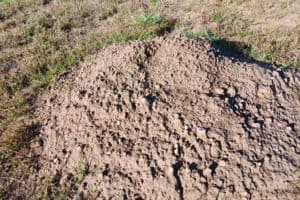If the weeds growing on our property are any indication, itís going to be a pretty intense tumbleweed season this year.As an article in Colorado Arts and Sciences Magazine explains, tumbleweeds are not a single species of weed, but a group of them. However, ìThe most familiar and probably the most common in the West is Russian thistle,î the article continues. And itís that pesky Russian thistle that has overtaken our property this year.Kochia is another common weed that gives rise to tumbleweeds. They are both summer annuals, according to Colorado State University Extension, and ìare troublesome annual weeds of rangelands, pastures, fields, disturbed areas, gardens, roadsides, ditch bank, and small acreages. If uncontrolled, they become tumbleweeds that can disperse seeds over a large area.îThe tumbleweed phase comes when the weed dries out, breaks free from the ground and scoots along the landscape propelled by wind. While the image of a tumbleweed blowing through a desolate town is an iconic image of the American West, Russian thistle is not native to the West but, as the name indicates, comes from Russia; you can thank a contaminated shipment of flaxseed in the late 1800s for its introduction in the United States. Itís now found in every state except Alaska and Florida, CSU Extension states.Russian thistle is not listed as a noxious weed by El Paso County; thus, the county Environmental Division does not try to monitor or control it. So I asked my neighbors on Nextdoor, the online community hub, if they were seeing an overabundance of Russian thistle as we head into fall, aka tumbleweed season.ìYes,î one person responded, ìmore than Iíve ever seen in the 14 years I lived here.îìTerrible this year,î another posted.ìUgh, the Russian thistle is AWFUL on my property this year,î Amy Lunde responded. ìIíve literally filled up eight, fifty gallon contractor bags and barely made a dent. Iím allergic to it as well, so pulling it is Ö an adventure.îItís too soon to know whether this bumper crop of Russian thistle will indeed translate into a tumbleweed-heavy fall. But tumbleweeds have made quite an impression in some past years.ìWeíve lived here 28 years,î one man commented on Nextdoor. ìI remember one year that the tumbleweeds were up to rooftops in Hanover. People used snowblowers with tines retrofitted. Local road crews had some special vehicles to keep the roads clear.îThat may have been 2014, a year that saw multiple counties declare a state of emergency as they faced a tumbleweed onslaught, with El Paso County using snowplows to clear some roads. But just last year, one Pueblo neighborhood was buried in tumbleweeds, ìItís like being on an alien planet,î a homeowner whose house was surrounded by tumbleweeds told a TV station.So, how to control Russian thistle before it escalates into a tumbleweed apocalypse?ìMowing can be effective on smaller plants,î CSU Extension explains. ìTillage and hand hoeing can control both seedling and larger plants as the plants have shallow root systems.îThanks to those shallow root systems, the Russian thistle is pretty easy to pull out of the ground. And Iíve been doing a lot of pulling recently. For a time, I was feeding the Russian thistle to the goats, who seem to enjoy it. But I stopped after I saw this warning from CSU Extension: While Russian thistle can provide ìfair forageî for animals when the plant is young, ìRussian thistle can accumulate toxic levels of nitrates, which can cause acute respiratory difficulty and sudden death in cattle and sheep. Russian thistle contains oxalates, which may result in kidney failure in cattle and sheep if ingested.îThat didnít stop people from feeding Russian thistle to cattle during the Dust Bowl, when it was about the only thing growing, or eating it themselves during the Great Depression.ìTumbleweed, or Russian thistle, is edible raw or cooked like greens ó but you have to eat it when itís young and soft,î according to an entry online from True West Magazine. ìNavajos have been making tumbleweed soup for generations.îAnother surprising potential use for tumbleweeds: ìA preliminary study reveals that tumbleweeds, aka Russian thistle, and some other weeds common to dry Western lands have a knack for soaking up depleted uranium from contaminated soils at weapons testing grounds and battlefields,î a Science Daily article recounted back in 2004.And, finally, there is apparently a role for tumbleweeds in home dÈcor. ìYou would be amazed and surprised how much fun you can have with tumbleweeds in your dÈcor,î touts Pinterest.Not in our house, thanks. And as our soils here are not contaminated with uranium as far as I know, and since I donít have a hankering for tumbleweed soup, I guess our Russian thistle will continue to go into the trash.





